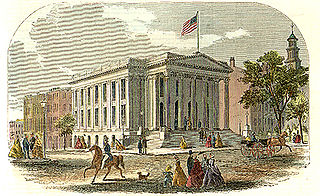 W
WThe imperial and US customary measurement systems are both derived from an earlier English system of measurement which in turn can be traced back to Ancient Roman units of measurement, and Carolingian and Saxon units of measure.
 W
WThe acre is a unit of land area used in the imperial and US customary systems. It is traditionally defined as the area of one chain by one furlong, which is exactly equal to 10 square chains, 1⁄640 of a square mile, 4,840 square yards, or 43,560 square feet, and approximately 4,047 m2, or about 40% of a hectare. Based upon the International yard and pound agreement of 1959, an acre may be declared as exactly 4,046.8564224 square metres. The acre was sometimes abbreviated ac, but was often spelled out as the word "acre".
 W
WThe avoirdupois system is a measurement system of weights that uses pounds and ounces as units. It was first commonly used in the 13th century AD and was updated in 1959.
 W
WA barrel is one of several units of volume applied in various contexts; there are dry barrels, fluid barrels, oil barrels, and so forth. For historical reasons the volumes of some barrel units are roughly double the volumes of others; volumes in common use range approximately from 100 to 200 litres. In many connections the term drum is used almost interchangeably with barrel.
 W
WA bushel is an imperial and US customary unit of volume based upon an earlier measure of dry capacity. The old bushel is equal to 2 kennings (obsolete), 4 pecks, or 8 dry gallons, and was used mostly for agricultural products, such as wheat. In modern usage, the volume is nominal, with bushels denoting a mass defined differently for each commodity.
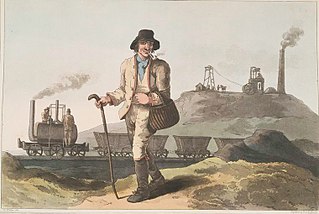 W
WA chaldron was an English measure of dry volume, mostly used for coal; the word itself is an obsolete spelling of cauldron. It was used from the 13th century onwards, nominally until 1963, when it was abolished by the Weights and Measures Act 1963, but in practice until the end of 1835, when the Weights and Measures Act of that year specified that thenceforth coal could only be sold by weight.
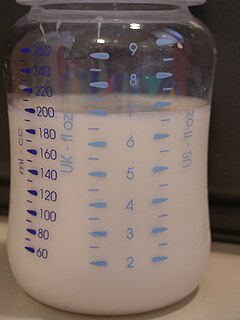 W
WBoth the British Imperial and United States customary systems of measurement derive from earlier English systems used in the Middle Ages, that were the result of a combination of the local Anglo-Saxon units inherited from Germanic tribes and Roman units brought by William the Conqueror after the Norman Conquest of England in 1066.
 W
WThe cubic inch is a unit of volume in the Imperial units and United States customary units systems. It is the volume of a cube with each of its three dimensions being one inch long which is equivalent to 1/231 of a US gallon.
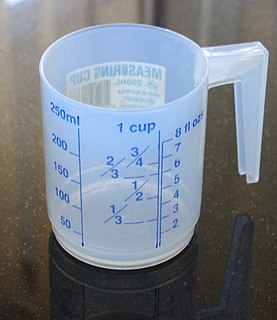 W
WThe cup is a cooking measure of volume, commonly associated with cooking and serving sizes. It is traditionally equal to one-half US pint (236.6 ml). Because actual drinking cups may differ greatly from the size of this unit, standard measuring cups may be used, with a metric cup being 250 millilitres.
 W
WA degree, usually denoted by °, is a measurement of a plane angle in which one full rotation is 360 degrees.
 W
WThe Fahrenheit scale is a temperature scale based on one proposed in 1724 by the physicist Daniel Gabriel Fahrenheit (1686–1736). It uses the degree Fahrenheit as the unit. Several accounts of how he originally defined his scale exist, but the original paper suggests the lower defining point, 0 °F, was established as the freezing temperature of a solution of brine made from a mixture of water, ice, and ammonium chloride. The other limit established was his best estimate of the average human body temperature, originally set at 90 °F, then 96 °F. However, he noted a middle point of 32 °F, to be set to the temperature of ice water.
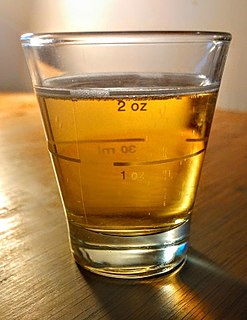 W
WA fluid ounce is a unit of volume typically used for measuring liquids. Various definitions have been used throughout history, but only two are still in common use: the British Imperial and the United States customary fluid ounce.
 W
WA foot-candle is a non-SI unit of illuminance or light intensity. The foot-candle is defined as one lumen per square foot. This unit is commonly used in lighting layouts in parts of the world where United States customary units are used, mainly the United States. Most of the world uses the corresponding SI derived unit lux, defined as one lumen per square meter.
 W
WA furlong is a measure of distance in imperial units and United States customary units equal to one eighth of a mile, equivalent to 660 feet, 220 yards, 40 rods, 10 chains or approximately 201 metres. In the United States, some states use older definitions for surveying purposes, leading to variations in the length of the furlong of two parts per million, or about 0.4 millimetre. This variation is too small to have practical consequences in most applications.
 W
WThe gallon is a unit of volume in imperial units and United States customary units. Three different versions are in current use:the imperial gallon, defined as 4.54609 litres, which is or was used in the United Kingdom, Canada, and some Caribbean countries; the US gallon defined as 231 cubic inches, which is used in the US and some Latin American and Caribbean countries; and the US dry gallon ("usdrygal"), defined as 1⁄8 US bushel.
 W
WThe gill or teacup is a unit of measurement for volume equal to a quarter of a pint. It is no longer in common use, except in regard to the volume of alcoholic spirits measures.In imperial units In United States customary units
 W
WA grain is an obsolescent unit of measurement of mass, and in the troy weight, avoirdupois, and Apothecaries' system, equal to exactly 64.79891 milligrams. It is nominally based upon the mass of a single ideal seed of a cereal. From the Bronze Age into the Renaissance the average masses of wheat and barley grains were part of the legal definitions of units of mass. Expressions such as "thirty-two grains of wheat, taken from the middle of the ear" appear to have been ritualistic formulas, essentially the premodern equivalent of legal boilerplate. Another source states that it was defined as the weight needed for 252.458 units to balance a cubic inch of distilled water at 30 inches of mercury pressure and 62 degrees Fahrenheit for both the air and water. Another book states that Captain Henry Kater, of the British Standards Commission, arrived at this value experimentally.
 W
WGunter's chain is a distance measuring device used for surveying. It was designed and introduced in 1620 by English clergyman and mathematician Edmund Gunter (1581–1626). It enabled plots of land to be accurately surveyed and plotted, for legal and commercial purposes.
 W
WThe hand is a non-SI unit of measurement of length standardized to 4 in (101.6 mm). It is used to measure the height of horses in many English-speaking countries, including Australia, Canada, the Republic of Ireland, the United Kingdom, and the United States. It was originally based on the breadth of a human hand. The adoption of the international inch in 1959 allowed for a standardized imperial form and a metric conversion. It may be abbreviated to "h" or "hh". Although measurements between whole hands are usually expressed in what appears to be decimal format, the subdivision of the hand is not decimal but is in base 4, so subdivisions after the radix point are in quarters of a hand, which are inches. Thus, 62 inches is fifteen and a half hands, or 15.2 hh.
 W
WA hogshead is a large cask of liquid. More specifically, it refers to a specified volume, measured in either imperial or US customary measures, primarily applied to alcoholic beverages, such as wine, ale, or cider.
 W
WHorsepower (hp) is a unit of measurement of power, or the rate at which work is done, usually in reference to the output of engines or motors. There are many different standards and types of horsepower. Two common definitions used today are the mechanical horsepower, which is about 745.7 watts and the metric horsepower, which is approximately 735.5 watts.
 W
WThe hundredweight, formerly also known as the centum weight or quintal, is a British imperial and US customary unit of weight or mass. Its value differs between the US and British imperial systems. The two values are distinguished in American English as the "short" and "long" hundredweight and in British English as the "cental" and the "imperial hundredweight".The short hundredweight or cental of 100 pounds (45.36 kg) is used in the United States. The long or imperial hundredweight of 8 stone or 112 pounds (50.80 kg) is defined in the imperial system.
 W
WThe imperial system of units, imperial system or imperial units is the system of units first defined in the British Weights and Measures Act 1824 and continued to be developed through a series of Weights and Measures Acts and amendments.
 W
WThe inch is a unit of length in the British imperial and the United States customary systems of measurement. It is equal to 1/36 yard or 1/12 of a foot. Derived from the Roman uncia ("twelfth"), the word inch is also sometimes used to translate similar units in other measurement systems, usually understood as deriving from the width of the human thumb.
 W
WThe pound per square inch or, more accurately, pound-force per square inch is a unit of pressure or of stress based on avoirdupois units. It is the pressure resulting from a force of one pound-force applied to an area of one square inch. In SI units, 1 psi is approximately equal to 6895 Pa.
 W
WThe mile, sometimes the international mile or statute mile to distinguish it from other miles, is a British imperial unit and US customary unit of distance; both are based on the older English unit of length equal to 5,280 English feet, or 1,760 yards. The statute mile was standardised between the British Commonwealth and the United States by an international agreement in 1959, when it was formally redefined with respect to SI units as exactly 1,609.344 metres.
 W
WMiles per hour is a British imperial and United States customary unit of speed expressing the number of miles travelled in one hour. It is used in the United Kingdom, the United States, and a number of smaller countries, most of which are UK or US territories, or have close historical ties with the UK or US.
 W
WA peck is an imperial and United States customary unit of dry volume, equivalent to 2 dry gallons or 8 dry quarts or 16 dry pints. An imperial peck is equivalent to 9.09 liters and a US customary peck is equivalent to 8.81 liters. Two pecks make a kenning (obsolete), and four pecks make a bushel. Although the peck is no longer widely used, some produce, such as apples, are still often sold by the peck in the USA.
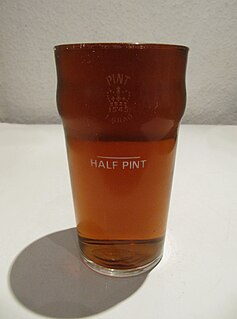 W
WThe pint is a unit of volume or capacity in both the imperial and United States customary measurement systems. In both of those systems it is traditionally one eighth of a gallon. The British imperial pint is about 20% larger than the American pint because the two systems are defined differently. Almost all other countries have standardized on the metric system, so the size of what may be called a pint, from the French la pinte, varies depending on local custom.
 W
WThe pound per square inch or, more accurately, pound-force per square inch is a unit of pressure or of stress based on avoirdupois units. It is the pressure resulting from a force of one pound-force applied to an area of one square inch. In SI units, 1 psi is approximately equal to 6895 Pa.
 W
WA span is the distance measured by a human hand, from the tip of the thumb to the tip of the little finger. In ancient times, a span was considered to be half a cubit. Sometimes the distinction is made between the great span or full span and little span or short span.
 W
WThe square foot is an imperial unit and U.S. customary unit of area, used mainly in the United States and partially in Canada, the United Kingdom, Bangladesh, India, Nepal, Pakistan, Ghana, Liberia, Malaysia, Myanmar, Singapore and Hong Kong. It is defined as the area of a square with sides of 1 foot.
 W
WThe square yard is an imperial unit and U.S. customary unit of area, formerly used in most of the English-speaking world, but now generally replaced by the square metre. However, it is still in widespread use in the United States, United Kingdom, Canada, Pakistan and India. It is defined as the area of a square with sides of one yard in length.
 W
WThe stone or stone weight is an English and imperial unit of mass equal to 14 pounds. The stone continues in customary use in the United Kingdom and Ireland for body weight.
 W
WStuck was a form occasionally found in English writing as a corruption of the German "Stück", itself an abbreviation of Stückfass, referring to the volume of a wine cask of around 1000-1200 litres. It was normally used in reference to German wine production.
 W
WA tablespoon is a large spoon. In many English-speaking regions, the term now refers to a large spoon used for serving; however, in some regions, it is the largest type of spoon used for eating.
 W
WA teaspoon (tsp.) is an item of cutlery. It is a small spoon that can be used to stir a cup of tea or coffee, or as a tool for measuring volume. The size of teaspoons ranges from about 2.5 to 7.3 mL. For cooking purposes and, more importantly, for dosing of medicine, a teaspoonful is defined as 5 mL, and standard measuring spoons are used.
 W
WTmcft, (Tmc ft), (TMC), (tmc), is the abbreviation of one thousand million cubic feet (1,000,000,000 = 109 = 1 billion), commonly used in India in reference to volume of water in a reservoir or river flow.
 W
WThe ton is a unit of measure. It has a long history and has acquired a number of meanings and uses over the years. It is used principally as a unit of weight. Its original use as a measurement of volume has continued in the capacity of cargo ships and in terms such as the freight ton. Recent specialized uses include the ton as a measure of energy and for truck classification. It is also a colloquial term, "ton" is the heaviest unit of weight typically used in colloquial speech. It is also used informally to mean a large amount of something, material or not.
 W
WThe twenty-foot equivalent unit is an inexact unit of cargo capacity, often used for container ships and container ports. It is based on the volume of a 20-foot-long (6.1 m) intermodal container, a standard-sized metal box which can be easily transferred between different modes of transportation, such as ships, trains, and trucks.
 W
WUnited States customary units form a system of measurement units commonly used in the United States and U.S. territories since being formalized in 1832. The United States customary system developed from English units which were in use in the British Empire before the U.S. became an independent country. The United Kingdom's system of measures was overhauled in 1824 to create the imperial system, which was officially adopted in 1826, changing the definitions of some of its units. Subsequently, while many U.S. units are essentially similar to their imperial counterparts, there are significant differences between the systems.
 W
WThe yard is an English unit of length, in both the British imperial and US customary systems of measurement, that comprises 3 feet or 36 inches. Since 1959 it is by international agreement standardized as exactly 0.9144 meter. A distance of 1,760 yards is equal to 1 mile.